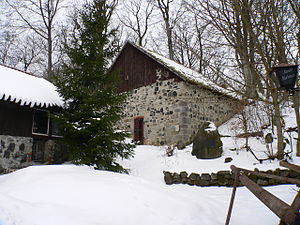Hildenburg
| Hildenburg | ||
|---|---|---|
|
Hildenburg castle ruins |
||
| Alternative name (s): | Hellmerk, Hilleberg, Hillenberger Höfe | |
| Creation time : | around 800 | |
| Castle type : | Höhenburg, spur location | |
| Conservation status: | ruin | |
| Place: | Hausen -Hillenberg | |
| Geographical location | 50 ° 29 '36.7 " N , 10 ° 6' 7.8" E | |
| Height: | 658 m above sea level NN | |
|
|
||
The Hildenburg , also known as Hellmerk, Hilleberg, Hillenberger Höfe , is the ruin of a medieval spur castle above the hamlet Hillenberg in the municipality of Hausen in the Lower Franconian district of Rhön-Grabfeld .
Geographical location
The hamlet of Hillenberg stands on historical ground. Here on a conical foothills northwest of Roth vor der Rhön at the entrance of the Baringau stood at 658 m above sea level. NN once the Hildenburg. This ruled the whole surrounding country.
history
The Hildenburg probably dates from the 8th century. In this context, a noble with the name Hiltiburg is mentioned in a document. She gave the abbot Rhabanus Maurus in Fulda around the year 824 several goods in Sondheim , Nordheim in Baringau and Nordheim in Gau Tussifeld .
Until the beginning of the 12th century, there was no story about the Hildenburg family. In 1116 a Cunemund vun Hildenburg appeared in a document as a witness. Albrecht von Hildenburg , who moved to the Holy Land as a crusader in 1188 , died around 1192. With Adalbert III. von Hildenburg († February 9, 1217/1228) ended the sex in the male line.
He left only one daughter, Adelheid, the heiress of the extensive Hildenburg estates. She married Count Otto III in 1228. von Bodenlaube from a branch of the Counts of Henneberg. He was a son of the famous minstrel Otto II von Bodenlaube and his wife Beatrix de Courtenay , who founded the Frauenroth monastery . He composed songs himself. In 1228 he had to with the consent of Adelaide's many of the extended hilde burg goods the bishoprics of Würzburg fief given and eventually sold in 1230 all their goods, including the Hildeburg, to the Bishopric of Würzburg. The Hildenburg became a high princely office.
The marriage lasted barely three years, however, as Otto entered the Teutonic Order and Adelheid entered the Dominican convent in Würzburg. The son of this marriage, Adelbert (Albert), was handed over to the Church as a child and destined for spiritual life. In 1231 Otto separated from his wife because of an obstacle to marriage that had only subsequently become known. Otto von Bodenlaube died a few years later. Albert died as the last of his tribe as a canon of Würzburg.
The Hildenburg remained the seat of the high ducal office until the 16th century. In 1335 the noble Heinrich von Fladungen was given the cents and the mayor's office via Hildenburg. When the office of Fladungen with Hildenburg was pledged to Count Georg von Henneberg-Aschach in 1435, the latter put Adolf Marschalk von Ostheim there as an official. He lived on the Hildenburg and in 1461 bought an estate in Nordheim. Valentin Vatt was the bailiff in Hildenberg until 1547 and in 1577 the castle was still inhabited by an official cellar, at least official days were held there. Hildenburg is still mentioned in 1596, but the bailiff lived in Fladungen as early as 1600. Since then, only farm farmers have lived on the Hildenburg.
The castle was probably destroyed by rebellious farmers from Bastheim in the Peasants' War in 1525 . They moved to the Hildenburg because they suspected the reformer Martin Luther to be there. It seems to be a legend that emerged later . Evidence of this is nowhere to be found.
There are other legends about the castle, for example that of a ghost train, a white maiden and a treasure hidden in the cellar. There are also said to be underground passages on the Hillenberge.
description
Only a few walls are evidence of the former Hildenburg castle complex. Parts of the keep and the foundation walls of the massive Bering are still preserved and enclose the farms in the hamlet of Hillenberg. According to the Trabert clergy, the tower was only demolished in the middle of the last century.
literature
- Festschrift for the inauguration of the new town hall with multi-purpose building in the municipality of Hausen / Rhön, inauguration from May 13th to May 15th, 1988
- Max Mölter: The Hochrhönstrasse . 3rd edition, Verlag Parzeller Fulda, Fulda 1971, ISBN 3-7900-0005-1 .



